Spring Security 图片验证码功能的实例代码
验证码逻辑
以前在项目中也做过验证码,生成验证码的代码网上有很多,也有一些第三方的jar包也可以生成漂亮的验证码。验证码逻辑很简单,就是在登录页放一个image标签,src指向一个controller,这个Controller返回把生成的图片以输出流返回给页面,生成图片的同时把图片上的文本放在session,登录的时候带过来输入的验证码,从session中取出,两者对比。这位老师讲的用Spring Security集成验证码,大体思路和我说的一样,但更加规范和通用些。
spring security是一系列的过滤器链,所以在这里验证码也声明为过滤器,加在过滤器链的 登录过滤器之前,然后自定义一个异常类,来响应验证码的错误信息。

代码结构:
验证码代码放在core项目,在browser项目做一下配置。
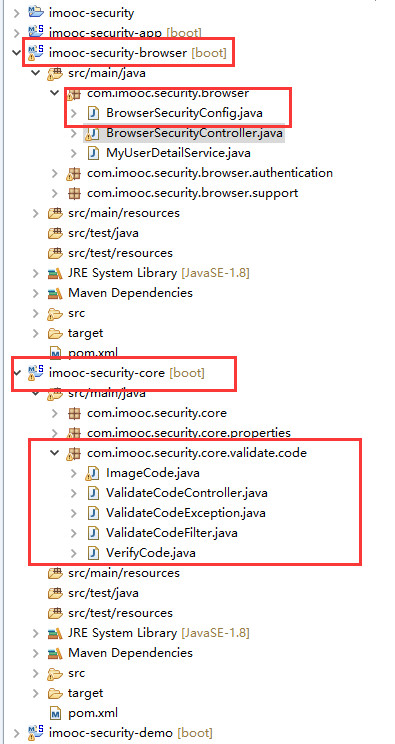
主要代码:
1,ImageCode:
首先是ImageCode类,封装验证码图片、文本、过期时间
package com.imooc.security.core.validate.code;
import java.awt.image.BufferedImage;
import java.time.LocalDateTime;
import java.time.LocalTime;
/**
* 验证码
* ClassName: ImageCode
* @Description: 验证码
* @author lihaoyang
* @date 2018年3月1日
*/
public class ImageCode {
private BufferedImage image;
private String code;
private LocalDateTime expireTime;//过期时间点
/**
*
* <p>Description: </p>
* @param image
* @param code
* @param expireTn 多少秒过期
*/
public ImageCode(BufferedImage image, String code, int expireTn) {
super();
this.image = image;
this.code = code;
//过期时间=当前时间+过期秒数
this.expireTime = LocalDateTime.now().plusSeconds(expireTn);
}
public ImageCode(BufferedImage image, String code, LocalDateTime expireTime) {
super();
this.image = image;
this.code = code;
this.expireTime = expireTime;
}
/**
* 验证码是否过期
* @Description: 验证码是否过期
* @param @return true 过期,false 没过期
* @return boolean true 过期,false 没过期
* @throws
* @author lihaoyang
* @date 2018年3月2日
*/
public boolean isExpired(){
return LocalDateTime.now().isAfter(expireTime);
}
public BufferedImage getImage() {
return image;
}
public void setImage(BufferedImage image) {
this.image = image;
}
public String getCode() {
return code;
}
public void setCode(String code) {
this.code = code;
}
public LocalDateTime getExpireTime() {
return expireTime;
}
public void setExpireTime(LocalDateTime expireTime) {
this.expireTime = expireTime;
}
}
VerifyCode:生成验证码的工具类,在这里http://www.cnblogs.com/lihaoyang/p/7131512.html 当然也可以使用第三方jar包,无所谓。
ValidateCodeException:封装验证码异常
/**
* @Title: ValidateCodeException.java
* @Package com.imooc.security.core.validate.code
* @Description: TODO
* @author lihaoyang
* @date 2018年3月2日
*/
package com.imooc.security.core.validate.code;
import org.springframework.security.core.AuthenticationException;
/**
* ClassName: ValidateCodeException
* @Description: 验证码错误异常,继承spring security的认证异常
* @author lihaoyang
* @date 2018年3月2日
*/
public class ValidateCodeException extends AuthenticationException {
/**
* @Fields serialVersionUID : TODO
*/
private static final long serialVersionUID = 1L;
public ValidateCodeException(String msg) {
super(msg);
}
}
ValidateCodeFilter:验证码过滤器
逻辑:继承OncePerRequestFilter 保证过滤器每次只会被调用一次(不太清楚为什么),注入认证失败处理器,在验证失败时调用。
package com.imooc.security.core.validate.code;
import java.io.IOException;
import javax.servlet.FilterChain;
import javax.servlet.ServletException;
import javax.servlet.http.HttpServletRequest;
import javax.servlet.http.HttpServletResponse;
import org.apache.commons.lang.StringUtils;
import org.springframework.security.web.authentication.AuthenticationFailureHandler;
import org.springframework.social.connect.web.HttpSessionSessionStrategy;
import org.springframework.social.connect.web.SessionStrategy;
import org.springframework.web.bind.ServletRequestBindingException;
import org.springframework.web.bind.ServletRequestUtils;
import org.springframework.web.context.request.ServletWebRequest;
import org.springframework.web.filter.OncePerRequestFilter;
/**
* 处理登录验证码过滤器
* ClassName: ValidateCodeFilter
* @Description:
* OncePerRequestFilter:spring提供的工具,保证过滤器每次只会被调用一次
* @author lihaoyang
* @date 2018年3月2日
*/
public class ValidateCodeFilter extends OncePerRequestFilter{
//认证失败处理器
private AuthenticationFailureHandler authenticationFailureHandler;
//获取session工具类
private SessionStrategy sessionStrategy = new HttpSessionSessionStrategy();
@Override
protected void doFilterInternal(HttpServletRequest request, HttpServletResponse response, FilterChain filterChain)
throws ServletException, IOException {
//如果是 登录请求 则执行
if(StringUtils.equals("/authentication/form", request.getRequestURI())
&&StringUtils.equalsIgnoreCase(request.getMethod(), "post")){
try {
validate(new ServletWebRequest(request));
} catch (ValidateCodeException e) {
//调用错误处理器,最终调用自己的
authenticationFailureHandler.onAuthenticationFailure(request, response, e);
return ;//结束方法,不再调用过滤器链
}
}
//不是登录请求,调用其它过滤器链
filterChain.doFilter(request, response);
}
/**
* 校验验证码
* @Description: 校验验证码
* @param @param request
* @param @throws ServletRequestBindingException
* @return void
* @throws ValidateCodeException
* @author lihaoyang
* @date 2018年3月2日
*/
private void validate(ServletWebRequest request) throws ServletRequestBindingException {
//拿出session中的ImageCode对象
ImageCode imageCodeInSession = (ImageCode) sessionStrategy.getAttribute(request, ValidateCodeController.SESSION_KEY);
//拿出请求中的验证码
String imageCodeInRequest = ServletRequestUtils.getStringParameter(request.getRequest(), "imageCode");
//校验
if(StringUtils.isBlank(imageCodeInRequest)){
throw new ValidateCodeException("验证码不能为空");
}
if(imageCodeInSession == null){
throw new ValidateCodeException("验证码不存在,请刷新验证码");
}
if(imageCodeInSession.isExpired()){
//从session移除过期的验证码
sessionStrategy.removeAttribute(request, ValidateCodeController.SESSION_KEY);
throw new ValidateCodeException("验证码已过期,请刷新验证码");
}
if(!StringUtils.equalsIgnoreCase(imageCodeInSession.getCode(), imageCodeInRequest)){
throw new ValidateCodeException("验证码错误");
}
//验证通过,移除session中验证码
sessionStrategy.removeAttribute(request, ValidateCodeController.SESSION_KEY);
}
public AuthenticationFailureHandler getAuthenticationFailureHandler() {
return authenticationFailureHandler;
}
public void setAuthenticationFailureHandler(AuthenticationFailureHandler authenticationFailureHandler) {
this.authenticationFailureHandler = authenticationFailureHandler;
}
}
ValidateCodeController:生成验证码Control
package com.imooc.security.core.validate.code;
import java.io.IOException;
import javax.imageio.ImageIO;
import javax.servlet.http.HttpServletRequest;
import javax.servlet.http.HttpServletResponse;
import org.springframework.social.connect.web.HttpSessionSessionStrategy;
import org.springframework.social.connect.web.SessionStrategy;
import org.springframework.web.bind.annotation.GetMapping;
import org.springframework.web.bind.annotation.RestController;
import org.springframework.web.context.request.ServletWebRequest;
/**
* 验证码Control
* ClassName: ValidateCodeController
* @Description: TODO
* @author lihaoyang
* @date 2018年3月1日
*/
@RestController
public class ValidateCodeController {
public static final String SESSION_KEY = "SESSION_KEY_IMAGE_CODE";
//获取session
private SessionStrategy sessionStrategy = new HttpSessionSessionStrategy();
@GetMapping("/verifycode/image")
public void createCode(HttpServletRequest request,HttpServletResponse response) throws IOException{
ImageCode imageCode = createImageCode(request, response);
sessionStrategy.setAttribute(new ServletWebRequest(request), SESSION_KEY, imageCode);
ImageIO.write(imageCode.getImage(), "JPEG", response.getOutputStream());
}
private ImageCode createImageCode(HttpServletRequest request, HttpServletResponse response) {
VerifyCode verifyCode = new VerifyCode();
return new ImageCode(verifyCode.getImage(),verifyCode.getText(),60);
}
}
BrowserSecurityConfig里进行过滤器配置:
package com.imooc.security.browser;
import org.springframework.beans.factory.annotation.Autowired;
import org.springframework.context.annotation.Bean;
import org.springframework.context.annotation.Configuration;
import org.springframework.security.config.annotation.web.builders.HttpSecurity;
import org.springframework.security.config.annotation.web.configuration.WebSecurityConfigurerAdapter;
import org.springframework.security.crypto.bcrypt.BCryptPasswordEncoder;
import org.springframework.security.crypto.password.PasswordEncoder;
import org.springframework.security.web.authentication.AuthenticationFailureHandler;
import org.springframework.security.web.authentication.AuthenticationSuccessHandler;
import org.springframework.security.web.authentication.UsernamePasswordAuthenticationFilter;
import com.imooc.security.core.properties.SecurityProperties;
import com.imooc.security.core.validate.code.ValidateCodeFilter;
@Configuration //这是一个配置
public class BrowserSecurityConfig extends WebSecurityConfigurerAdapter{
//读取用户配置的登录页配置
@Autowired
private SecurityProperties securityProperties;
//自定义的登录成功后的处理器
@Autowired
private AuthenticationSuccessHandler imoocAuthenticationSuccessHandler;
//自定义的认证失败后的处理器
@Autowired
private AuthenticationFailureHandler imoocAuthenticationFailureHandler;
//注意是org.springframework.security.crypto.password.PasswordEncoder
@Bean
public PasswordEncoder passwordencoder(){
//BCryptPasswordEncoder implements PasswordEncoder
return new BCryptPasswordEncoder();
}
//版本二:可配置的登录页
@Override
protected void configure(HttpSecurity http) throws Exception {
//验证码过滤器
ValidateCodeFilter validateCodeFilter = new ValidateCodeFilter();
//验证码过滤器中使用自己的错误处理
validateCodeFilter.setAuthenticationFailureHandler(imoocAuthenticationFailureHandler);
//实现需要认证的接口跳转表单登录,安全=认证+授权
//http.httpBasic() //这个就是默认的弹框认证
//
http.addFilterBefore(validateCodeFilter, UsernamePasswordAuthenticationFilter.class)//把验证码过滤器加载登录过滤器前边
.formLogin() //表单认证
.loginPage("/authentication/require") //处理用户认证BrowserSecurityController
//登录过滤器UsernamePasswordAuthenticationFilter默认登录的url是"/login",在这能改
.loginProcessingUrl("/authentication/form")
.successHandler(imoocAuthenticationSuccessHandler)//自定义的认证后处理器
.failureHandler(imoocAuthenticationFailureHandler) //登录失败后的处理
.and()
.authorizeRequests() //下边的都是授权的配置
// /authentication/require:处理登录,securityProperties.getBrowser().getLoginPage():用户配置的登录页
.antMatchers("/authentication/require",
securityProperties.getBrowser().getLoginPage(),//放过登录页不过滤,否则报错
"/verifycode/image").permitAll() //验证码
.anyRequest() //任何请求
.authenticated() //都需要身份认证
.and()
.csrf().disable() //关闭csrf防护
;
}
}
登陆页:登陆页做的比较粗糙,其实验证码可以在验证码input失去焦点的时候做校验,还可以做个点击图片刷新验证码功能,这里就不做了。
<body> demo 登录页. <br> <form action="/authentication/form" method="post"> <table> <tr> <td>用户名:</td> <td><input type="text" name="username"/></td> <td></td> </tr> <tr> <td>密码:</td> <td><input type="password" name="password"/></td> <td></td> </tr> <tr> <td>验证码:</td> <td> <input width="100" type="text" name="imageCode"/> </td> <td> <img src="/verifycode/image"/> </td> </tr> <tr> <td colspan="2" align="right"><button type="submit">登录</button></td> </tr> </table> </form> </body>
访问 http://localhost:8080/demo-login.html:
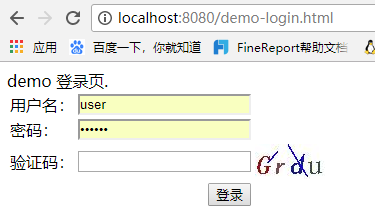
响应自定义的异常信息

大体功能已经没问题了。但是不够通用,比如验证码图片的宽高、过期时间、过滤的url、验证码成逻辑都是写死的。这些可以做成活的,现在把验证码做成一个过滤器的好处体现出来了。我们可以配置需要过滤的url,有时候可能不只是登陆页需要验证码,这样更加通用。
1,通用性改造 之 验证码基本参数可配
做成可配置的,那个应用引用该模块,他自己配置去,不配置就使用默认配置。而且,配置既可以在请求url中声明,也可以在应用中声明,老师的确是老师,代码通用性真好!
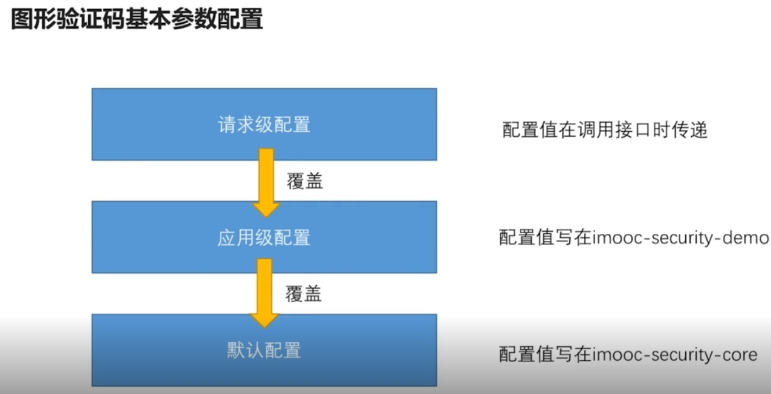
想要实现的效果是,在application.properties里做这样的配置:
#验证码 图片宽、高、字符个数 imooc.security.code.image.width = 100 imooc.security.code.image.height = 30 imooc.security.code.image.length = 6
然后就能控制验证码的效果,因为验证码还分图片验证码、短信验证码,所以多做了一级.code.image,这就用到了springboot的自定义配置文件,需要声明对应的java类:
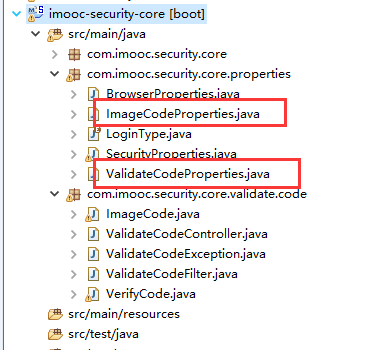
需要在SecurityProperties里声明code属性:
package com.imooc.security.core.properties;
import org.springframework.boot.context.properties.ConfigurationProperties;
import org.springframework.context.annotation.Configuration;
/**
* 自定义配置项
* ClassName: SecurityProperties
* @Description: 自定义配置项
* 这个类会读取application.properties里所有以imooc.security开头的配置项
*
* imooc.security.browser.loginPage = /demo-login.html
* 其中的browser的配置会读取到BrowserProperties中去
* 这是以点分割的,一级一级的和类的属性对应
* @author lihaoyang
* @date 2018年2月28日
*/
@ConfigurationProperties(prefix="imooc.security")
public class SecurityProperties {
private BrowserProperties browser = new BrowserProperties();
private ValidateCodeProperties code = new ValidateCodeProperties();
public BrowserProperties getBrowser() {
return browser;
}
public void setBrowser(BrowserProperties browser) {
this.browser = browser;
}
public ValidateCodeProperties getCode() {
return code;
}
public void setCode(ValidateCodeProperties code) {
this.code = code;
}
}
ValidateCodeProperties:
package com.imooc.security.core.properties;
/**
* 验证码配置
* ClassName: ValidateCodeProperties
* @Description: 验证码配置,验证码有图片验证码、短信验证码等,所以再包一层
* @author lihaoyang
* @date 2018年3月2日
*/
public class ValidateCodeProperties {
//默认配置
private ImageCodeProperties image = new ImageCodeProperties();
public ImageCodeProperties getImage() {
return image;
}
public void setImage(ImageCodeProperties image) {
this.image = image;
}
}
ImageCodeProperties:
package com.imooc.security.core.properties;
/**
* 图片验证码配置类
* ClassName: ImageCodeProperties
* @Description: 图片验证码配置类
* @author lihaoyang
* @date 2018年3月2日
*/
public class ImageCodeProperties {
//图片宽
private int width = 67;
//图片高
private int height = 23;
//验证码字符个数
private int length = 4;
//过期时间
private int expireIn = 60;
public int getWidth() {
return width;
}
public void setWidth(int width) {
this.width = width;
}
public int getHeight() {
return height;
}
public void setHeight(int height) {
this.height = height;
}
public int getLength() {
return length;
}
public void setLength(int length) {
this.length = length;
}
public int getExpireIn() {
return expireIn;
}
public void setExpireIn(int expireIn) {
this.expireIn = expireIn;
}
}
请求级的配置,如果请求里带的有验证码的参数,就用请求里的:

在ValidateCodeController的createImageCode方法做控制,判断请求参数是否有这些参数,有的话,传给验证码生成类VerifyCode,在生成的时候就能动态控制了。
private ImageCode createImageCode(HttpServletRequest request, HttpServletResponse response) {
//先从request里读取有没有长、宽、字符个数参数,有的话就用,没有用默认的
int width = ServletRequestUtils.getIntParameter(request, "width",securityProperties.getCode().getImage().getWidth());
int height = ServletRequestUtils.getIntParameter(request, "height",securityProperties.getCode().getImage().getHeight());
int charLength = this.securityProperties.getCode().getImage().getLength();
VerifyCode verifyCode = new VerifyCode(width,height,charLength);
return new ImageCode(verifyCode.getImage(),verifyCode.getText(),this.securityProperties.getCode().getImage().getExpireIn());
}
VerifyCode:
public VerifyCode(int w, int h, int charLength) {
super();
this.w = w;
this.h = h;
this.charLength = charLength;
}
实验:在demo项目做应用级配置

登录表单做请求级配置
<img src="/verifycode/image?width=200"/>
访问:
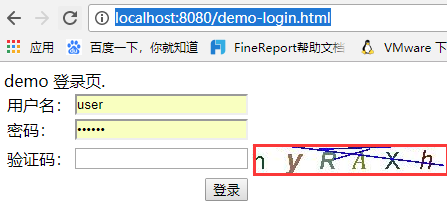
长度为请求级带的参数200,高为30,字符为配置的6个。
2,通用性改造 之 验证码拦截的接口可配置
先要的效果就是再application.properties里能动态配置需要拦截的接口:

ImageCodeProperties新增一个属性:private String url; //拦截的url,来匹配上图的配置。
核心,验证码过滤器需要修改:
1,在拦截器里声明一个set集合,用来存储配置文件里配置的需要拦截的urls。
2,实现InitializingBean接口,目的: 在其他参数都组装完毕的时候,初始化需要拦截的urls的值,重写afterPropertiesSet方法来实现。
3,注入SecurityProperties,读取配置文件
4,实例化AntPathMatcher工具类,这是一个匹配器
5,在browser项目的BrowserSecurityConfig里设置调用一下afterPropertiesSet方法。
6,在引用该模块的demo项目的application.properties里配置要过滤的url
ValidateCodeFilter:
/**
* 处理登录验证码过滤器
* ClassName: ValidateCodeFilter
* @Description:
* 继承OncePerRequestFilter:spring提供的工具,保证过滤器每次只会被调用一次
* 实现 InitializingBean接口的目的:
* 在其他参数都组装完毕的时候,初始化需要拦截的urls的值
* @author lihaoyang
* @date 2018年3月2日
*/
public class ValidateCodeFilter extends OncePerRequestFilter implements InitializingBean{
//认证失败处理器
private AuthenticationFailureHandler authenticationFailureHandler;
//获取session工具类
private SessionStrategy sessionStrategy = new HttpSessionSessionStrategy();
//需要拦截的url集合
private Set<String> urls = new HashSet<>();
//读取配置
private SecurityProperties securityProperties;
//spring工具类
private AntPathMatcher antPathMatcher = new AntPathMatcher();
@Override
public void afterPropertiesSet() throws ServletException {
super.afterPropertiesSet();
//读取配置的拦截的urls
String[] configUrls = StringUtils.splitByWholeSeparatorPreserveAllTokens(securityProperties.getCode().getImage().getUrl(), ",");
for (String configUrl : configUrls) {
urls.add(configUrl);
}
//登录的请求一定拦截
urls.add("/authentication/form");
}
@Override
protected void doFilterInternal(HttpServletRequest request, HttpServletResponse response, FilterChain filterChain)
throws ServletException, IOException {
/**
* 可配置的验证码校验
* 判断请求的url和配置的是否有匹配的,匹配上了就过滤
*/
boolean action = false;
for(String url:urls){
if(antPathMatcher.match(url, request.getRequestURI())){
action = true;
}
}
if(action){
try {
validate(new ServletWebRequest(request));
} catch (ValidateCodeException e) {
//调用错误处理器,最终调用自己的
authenticationFailureHandler.onAuthenticationFailure(request, response, e);
return ;//结束方法,不再调用过滤器链
}
}
//不是登录请求,调用其它过滤器链
filterChain.doFilter(request, response);
}
//省略无关代码,,,
}
BrowserSecurityConfig:

配置url:
#验证码拦截的接口配置 imooc.security.code.image.url = /user,/user/*
测试:/user /user/1 被拦截了


访问登录页,不写验证码:

和预期一致。至此,动态配置拦截接口完成
3,验证码的生成逻辑可配置
写的比较好的程序,一般都开放接口,可以让用户去自定义实现,如果不实现就用默认的实现,下面来做这件事,使验证码的生成可以自己实现。如果要想把验证码的生成逻辑做成可配置的,就不能只写一个图片验证码生成器的类了,需要把验证码生成提取成一个接口ValidateCodeGenerator,一个生成验证码的方法generator()。因为验证码还有图片验证码、短信验证码等,这样,我们在自己的验证模块里做一个默认的实现,如图片验证码的实现ImageCodeGenerator,在ImageCodeGenerator里我们不在该类上加@Component注解。然后使用写一个验证码bean的配置类ValidateCodeBeanConfig,这个配置类配置各种需要的验证码实现类bean如图片验证码实现imageCodeGenerator、短信验证码等,他们返回类型都是ValidateCodeGenerator,使用@ConditionalOnMissingBean(name="imageCodeGenerator")注解,可以判断如果当前spring容器有名字为imageCodeGenerator的bean时,就使用,没有的话再配置,这样如果别人引用了你的该模块,如果别人自己实现了验证码生成ValidateCodeGenerator接口,他们配置了实现类的name为imageCodeGenerator,就用他们自己的实现,这样就做到了程序的可扩展性。
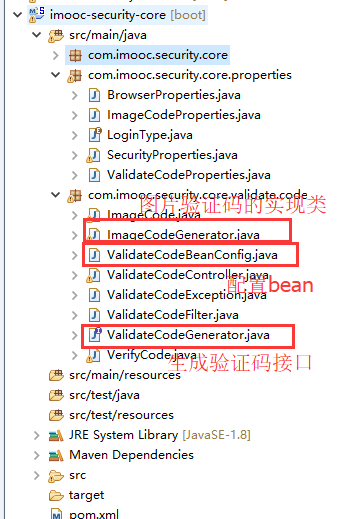
主要代码:
代码生成器接口ValidateCodeGenerator:
package com.imooc.security.core.validate.code;
import org.springframework.web.context.request.ServletWebRequest;
/**
* 验证码生成接口
* ClassName: ValidateCodeGenerator
* @Description: TODO
* @author lihaoyang
* @date 2018年3月2日
*/
public interface ValidateCodeGenerator {
/**
* 图片验证码生成接口
* @Description: TODO
* @param @param request
* @param @return
* @return ImageCode
* @throws
* @author lihaoyang
* @date 2018年3月2日
*/
ImageCode generator(ServletWebRequest request);
}
图片验证码生成器实现ImageCodeGenerator:
package com.imooc.security.core.validate.code;
import org.springframework.beans.factory.annotation.Autowired;
import org.springframework.stereotype.Component;
import org.springframework.web.bind.ServletRequestUtils;
import org.springframework.web.context.request.ServletWebRequest;
import com.imooc.security.core.properties.SecurityProperties;
/**
* 图片验证码生成类
* ClassName: ImageCodeGenerator
* @Description: TODO
* @author lihaoyang
* @date 2018年3月2日
*/
public class ImageCodeGenerator implements ValidateCodeGenerator {
@Autowired
private SecurityProperties securityProperties;
@Override
public ImageCode generator(ServletWebRequest request) {
//先从request里读取有没有长、宽、字符个数参数,有的话就用,没有用默认的
int width = ServletRequestUtils.getIntParameter(request.getRequest(), "width",securityProperties.getCode().getImage().getWidth());
int height = ServletRequestUtils.getIntParameter(request.getRequest(), "height",securityProperties.getCode().getImage().getHeight());
int charLength = this.securityProperties.getCode().getImage().getLength();
VerifyCode verifyCode = new VerifyCode(width,height,charLength);
return new ImageCode(verifyCode.getImage(),verifyCode.getText(),this.securityProperties.getCode().getImage().getExpireIn());
}
public SecurityProperties getSecurityProperties() {
return securityProperties;
}
public void setSecurityProperties(SecurityProperties securityProperties) {
this.securityProperties = securityProperties;
}
}
ValidateCodeBeanConfig:
package com.imooc.security.core.validate.code;
import org.springframework.beans.factory.annotation.Autowired;
import org.springframework.boot.autoconfigure.condition.ConditionalOnMissingBean;
import org.springframework.context.annotation.Bean;
import org.springframework.context.annotation.Configuration;
import com.imooc.security.core.properties.SecurityProperties;
/**
* 配置验证码生成接口ValidateCodeGenerator的实际实现类的Bean
* ClassName: ValidateCodeBeanConfig
* @Description:
* 配置验证码生成接口ValidateCodeGenerator的实际实现类的Bean
* 如图片验证码的实现、短信验证码的实现
* @author lihaoyang
* @date 2018年3月5日
*/
@Configuration
public class ValidateCodeBeanConfig {
@Autowired
private SecurityProperties securityProperties;
/**
* @Description:
* @ConditionalOnMissingBean注解意思是当spring容器不存在imageCodeGenerator时才给配置一个该bean
* 作用是使程序更具可扩展性,该配置类是配置在core模块,这就意味着,如果引用该模块的项目
* 如果有一个自己的实现,实现了ValidateCodeGenerator接口,定义了自己的实现,名字也叫imageCodeGenerator时,
* 就用应用级别的实现,没有的话就用这个默认实现。
* @param @return
* @return ValidateCodeGenerator
* @throws
* @author lihaoyang
* @date 2018年3月5日
*/
@Bean
@ConditionalOnMissingBean(name="imageCodeGenerator")
public ValidateCodeGenerator imageCodeGenerator(){
ImageCodeGenerator codeGenerator = new ImageCodeGenerator();
codeGenerator.setSecurityProperties(securityProperties);
return codeGenerator;
}
}
这样,如果哪个模块引用了这个验证码模块,他自定义了实现,如:
package com.imooc.code;
import org.springframework.stereotype.Component;
import org.springframework.web.context.request.ServletWebRequest;
import com.imooc.security.core.validate.code.ImageCode;
import com.imooc.security.core.validate.code.ValidateCodeGenerator;
@Component("imageCodeGenerator")
public class DemoImageCodeGenerator implements ValidateCodeGenerator {
@Override
public ImageCode generator(ServletWebRequest request) {
System.err.println("demo项目实现的生成验证码,,,");
return null;
}
}
这样ValidateCodeBeanConfig在配置验证码bean时,就会使用使用者自定义的实现。
完整代码放在了github:https://github.com/lhy1234/spring-security
总结
以上所述是小编给大家介绍的Spring Security 图片验证码功能的实例代码,希望对大家有所帮助,如果大家有任何疑问请给我留言,小编会及时回复大家的。在此也非常感谢大家对我们网站的支持!
您可能感兴趣的文章:
- spring security4 添加验证码的示例代码
- Spring Security Oauth2.0 实现短信验证码登录示例
- 详解使用Spring Security进行自动登录验证
- Spring Boot中整合Spring Security并自定义验证代码实例
- Spring Security验证流程剖析及自定义验证方法

